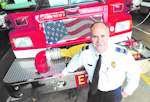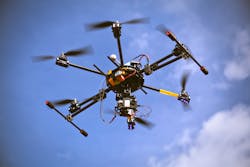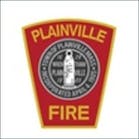Fire Technology: Using Drones In the Fire Service
Drones are likely to be one of the next big changes in the fire service. Drones, or unmanned aerial vehicles (UAVs), are flying vehicles that do not have a pilot and are controlled remotely. The topic of drones is a complicated one.
There are varying definitions and different acronyms for drones –UAV, unmanned aircraft system (UAS), unmanned aerial device (UAD), etc. – different types and sizes (airplane, helicopter, rotorcraft, etc.), different prices (from $200 to $2 million) and the federal regulations that apply to them.
Drones are best known for their use in the military for intelligence gathering and offensive operations. Today, there is confusion and concern to whether remote-controlled airplanes and helicopters used by recreational users will fall under the Federal Aviation Administration (FAA) regulations of UAVs. For the purpose of this column, drone and UAV will be used interchangeably.
Drones in the fire service
There are increasing examples of ways in which UAVs could be used by the fire service. Drones offer a great opportunity to assess information from significant incidents and large-scale events that can provide additional situational awareness to the incident commander. This information-gathering capability can help keep firefighters and other responders from unnecessary danger. While engaged in situational awareness, these devices can be equipped with video cameras to capture video and/or provide a live video feed. UAVs equipped with cameras (video and infrared) can also provide a real-time overview on the spread of wildland fires and the potential harm to firefighters, the public and the surrounding communities.
UAVs also provide a quick and safe way to capture information relating to problems and damage that have been resulted from catastrophic events such as floods, earthquakes, tornados and hurricanes. This early information helps incident commanders and emergency managers understand the magnitude of community impact on building infrastructure, road conditions and living conditions. This information provides insight as to what additional resources may be needed from neighboring communities and/or the Federal Emergency Management Agency (FEMA).
Further testing is ongoing as to UAVs use and operation during wildland firefighting operations. This testing includes the UAVs’ capability to be remotely operated to pick up water and deliver it where needed to extinguish the fire. Drones may also be equipped with remote monitoring devices that can be used for hazardous materials detection and monitoring a spill, leak, train derailment or other active hazmat incident. Radiological incidents such as a dirty bomb, nuclear reactor accident or radiological transportation incident present additional situations where drone-enabled monitoring devices can provide situational awareness about radiation levels from a safe distance.
UAVs have also been involved in searches for lost children and other missing persons. In 2014, a drone from Virginia Tech was used in the search for a missing University of Virginia student. In these cases, drones are particularly helpful to cover vast open fields much more rapidly than can be accomplished by foot. Drones also offer the ability to provide information from waterways by visualizing changes in water currents and identifying people who may be in trouble. Similarly, UAVs can access difficult terrain and cliffs that would otherwise be inaccessible to assess emergency situations and determine the best approach for a rescue of an injured person. By covering areas that are clearly visible by drone, it directs searchers in the various situations to areas that have not been searched more effectively.
UAVs can also provide value by providing a view of a building fire from above, showing rooftop attributes, trapped occupants at upper levels, threats to exposure buildings, infrared heat analysis and apparatus locations. Montgomery County, MD, Fire and Rescue purchased three drones in 2014 for use during firefighting operations, especially high-rise fires. These digital images and videos can also be saved and used for fire investigations, after-incident critiques and training.
Drones can also provide important information during major traffic accidents by visualizing the magnitude of the accident and its impact on traffic flow and share information to redirect traffic. This also helps to direct incoming units and direct emergency units responding to other emergencies around the accident.
Prior to a fire or incident, UAVs can be used to photograph facilities and the digital images can be included in pre-fire plans. The digital images within the pre-fire plans can be accessed by the incident commander during a fire and give a comparable look at rooftop/exposure features between normal conditions and fire conditions.
Drones are now available and range from $200 to the millions of dollars. As you may imagine, the escalation of price is directly related to the UAV’s size, durability, payload capability and the sophistication of its electronics (GPS, video camera, thermal image camera and satellite control). Even inexpensive drones can easily be deployed with a remote camera like Go-Pro video cameras.
Regulating drone use
FAA regulations currently control the use of UAVs in the United States. These regulations prevent the commercial use of drones until 2015 and are banned except for those that are used recreationally. This ban applies to the fire service and requires permission (certificate of authority) from the FAA prior to use. UAVs are prohibited in national parks, over military bases, near airports, air flight lanes and in restricted air space. The FAA is expected to place licensing requirements on UAV operators and Congress is expected to discuss drone legislation in 2015.
Australia has regulations covering drones used by commercial users and public safety overseen by the Civil Aviation and Safety Authority (CASA). UAVs must be kept a minimum of approximately 100 feet from people and they may not be flown over crowds or at beaches or sporting events. Drones are not allowed to be used after dark and they must be visible by the operator. They cannot operate within three miles of an airport and must be flown less than an altitude of 400 feet.
A man operating a drone commercially in Charlottesville, VA, was charged a $10,000 fine by the FAA, but the case was later settled for $1,000. A man in Sydney, Australia, was charged $850 for that offense.
In general, the current regulations requiring permission by the fire service during emergencies are complicated and impractical for short-lived emergency incidents. It will be important to watch updates to the UAV regulations/laws as they become updated this year.
Drone dangers
There have been documented dangers associated with drones that must be considered. Untrained drone operators pose one of the largest dangers. If improperly operated over crowds, UAVs can crash into people and injure them. Drones have also been known to fly into power lines, causing damage and power outages. Private UAVs have been blamed for disrupting air firefighting operations in several significant wildfires in the United States and Australia. To address this issue, the U.S. Forest Service and the Department of the Interior issued an Interagency Aviation Safety Alert about the hazards of UAVs operating near wildfires. Drones have also been documented operating in air space near commercial airliners. And on Jan. 30, 2015, a four-rotor UAV flew undetected and then crashed onto the South Lawn of the White House. Fortunately, the crash had no negative impact to property or people.
Dangers from operation around fires must also be a consideration as the environment will have a direct bearing on a UAV’s operation. There are also dangers of bringing a drone into an extremely flammable or an explosive atmosphere which could ignite a fire or cause an explosion.
There is a dark side to drones with a great concern regarding the intended negative use of UAVs. In January 2015, a drone carrying drugs crashed near the southern U.S. border. Another concern is that UAVs could be used to transport explosives or bombs as part of a terrorist attack. UAVs are able to travel very quickly and often go undetected.
Privacy issues
In addition to the UAV dangers already cited, it is also important to realize that like any other operation, there is an added level of personal and organizational liability that accompanies the use of drones. Many localities prohibit the use of drones due to concerns about inappropriate use and the invasion of privacy. About a year ago, the Charlottesville City Council enacted a two-year moratorium on drones to allow time for some of these issues to be addressed.
While it is clear that UAVs offer great value to the fire service, it is imperative that every fire department that seeks to use a drone understands the requirements (legal, operational, safety and liability) and commitment (training, operational readiness, policies and procedures) that will be needed to implement a successful UAV program.
IMPLEMENTING A DRONE PROGRAM
While drones offer many advantages for the fire service and public safety in general, numerous issues must still be addressed before deciding to purchase/implement a drone program. Here are a few tips:
1. Know local, state and national regulations and how they apply to your use of a drone.
2. Check with your locality or department lawyers to understand legalities and liabilities.
3. Understand and develop a strategy to publicly address assurances to privacy concerns.
4. Learn about the different types of drones available.
5. Define situations where a drone will enhance fire department operations.
6. Determine which drone seems to meet your needs the best (price, GPS, size, video, capability, ease of use, etc.)
7. Reach out to law enforcement agencies to determine whether they already have a drone and possibly develop a joint UAV program. In some cases, it may make more sense to develop a memorandum of understanding (MOU) with law enforcement and utilize their drone for fire department needs.
8. Determine where the drone will be stored.
9. Define how the drone will be maintained for operational readiness and by whom.
10. Develop the policies and procedures of when, how and by whom the drone will be used.
11. Develop a safety operational checklist that addresses every stage of operation.
12. Develop a drone training/certification program that ensures operational and safety proficiency.
13. Don’t abuse the use of the UAV.
—Charles Werner
CHARLES WERNER, a Firehouse® contributing editor, is a 40-year veteran of the career and volunteer fire service. He is the present fire chief of the Charlottesville, VA, Fire Department. Werner also serves on the Charlottesville-Albemarle-UVA Emergency Communications Center Management Board, Virginia Statewide Interoperability Executive Committee, Virginia Fire Service Council, National Alliance for Public Safety GIS, IAFC Technology Council and is chair of the National Information Sharing Consortium and co-chair of the joint White House/DHS Incident Management Information Sharing Sub Committee.
Connect with Charles
Email: [email protected]
pull quote:
While drones offer many advantages for the fire service and public safety in general, numerous issues must still be addressed.

Charles Werner
CHARLES WERNER, who is a Firehouse contributing editor, is a 45-year veteran of public safety. He served with the Charlottesville, VA, Fire Department for 37 years, serving the past 10 years as chief. Following retirement, Werner served for two years as senior adviser and acting deputy state coordinator for the Virginia Department of Emergency Management. He has chaired: DHS SAFECOM Executive Committee; IAFC Technology Council; National Information Sharing Consortium; and DHS/White House Incident Management Information Sharing SubCommittee. Werner currently serves as the director of DroneResponders Public Safety Alliance, chair of the National Council on Public Safety UAS and chair of the Virginia Secure Commonwealth UAS Sub Panel.





